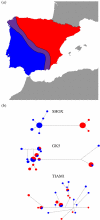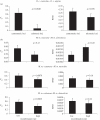Recombination rate variation and speciation: theoretical predictions and empirical results from rabbits and mice
- PMID: 22201170
- PMCID: PMC3233716
- DOI: 10.1098/rstb.2011.0249
Recombination rate variation and speciation: theoretical predictions and empirical results from rabbits and mice
Abstract
Recently diverged taxa may continue to exchange genes. A number of models of speciation with gene flow propose that the frequency of gene exchange will be lower in genomic regions of low recombination and that these regions will therefore be more differentiated. However, several population-genetic models that focus on selection at linked sites also predict greater differentiation in regions of low recombination simply as a result of faster sorting of ancestral alleles even in the absence of gene flow. Moreover, identifying the actual amount of gene flow from patterns of genetic variation is tricky, because both ancestral polymorphism and migration lead to shared variation between recently diverged taxa. New analytic methods have been developed to help distinguish ancestral polymorphism from migration. Along with a growing number of datasets of multi-locus DNA sequence variation, these methods have spawned a renewed interest in speciation models with gene flow. Here, we review both speciation and population-genetic models that make explicit predictions about how the rate of recombination influences patterns of genetic variation within and between species. We then compare those predictions with empirical data of DNA sequence variation in rabbits and mice. We find strong support for the prediction that genomic regions experiencing low levels of recombination are more differentiated. In most cases, reduced gene flow appears to contribute to the pattern, although disentangling the relative contribution of reduced gene flow and selection at linked sites remains a challenge. We suggest fruitful areas of research that might help distinguish between different models.
Figures




Similar articles
-
Recombination and speciation: loci near centromeres are more differentiated than loci near telomeres between subspecies of the European rabbit (Oryctolagus cuniculus).Genetics. 2009 Feb;181(2):593-606. doi: 10.1534/genetics.108.096826. Epub 2008 Nov 17. Genetics. 2009. PMID: 19015539 Free PMC article.
-
Higher differentiation among subspecies of the house mouse (Mus musculus) in genomic regions with low recombination.Mol Ecol. 2011 Nov;20(22):4722-36. doi: 10.1111/j.1365-294X.2011.05285.x. Epub 2011 Oct 18. Mol Ecol. 2011. PMID: 22004102 Free PMC article.
-
Linked selection and recombination rate variation drive the evolution of the genomic landscape of differentiation across the speciation continuum of Ficedula flycatchers.Genome Res. 2015 Nov;25(11):1656-65. doi: 10.1101/gr.196485.115. Epub 2015 Sep 9. Genome Res. 2015. PMID: 26355005 Free PMC article.
-
Islands of speciation or mirages in the desert? Examining the role of restricted recombination in maintaining species.Heredity (Edinb). 2009 Dec;103(6):439-44. doi: 10.1038/hdy.2009.151. Heredity (Edinb). 2009. PMID: 19920849 Free PMC article. Review.
-
Ancestral Population Genomics.Methods Mol Biol. 2019;1910:555-589. doi: 10.1007/978-1-4939-9074-0_18. Methods Mol Biol. 2019. PMID: 31278677 Review.
Cited by
-
A recombination suppressor contributes to ecological speciation in OSTRINIA moths.Heredity (Edinb). 2015 Jun;114(6):593-600. doi: 10.1038/hdy.2014.128. Epub 2015 Jan 28. Heredity (Edinb). 2015. PMID: 25626887 Free PMC article.
-
How to Investigate the Origins of Novelty: Insights Gained from Genetic, Behavioral, and Fitness Perspectives.Integr Org Biol. 2019 Aug 14;1(1):obz018. doi: 10.1093/iob/obz018. eCollection 2019. Integr Org Biol. 2019. PMID: 33791533 Free PMC article.
-
Linked selection, differential introgression and recombination rate variation promote heterogeneous divergence in a pair of yellow croakers.Mol Ecol. 2022 Nov;31(22):5729-5744. doi: 10.1111/mec.16693. Epub 2022 Sep 29. Mol Ecol. 2022. PMID: 36111361 Free PMC article.
-
Origin of the chromosomal radiation of Madeiran house mice: a microsatellite analysis of metacentric chromosomes.Heredity (Edinb). 2013 Apr;110(4):380-8. doi: 10.1038/hdy.2012.107. Epub 2012 Dec 12. Heredity (Edinb). 2013. PMID: 23232832 Free PMC article.
-
Genomics of divergence along a continuum of parapatric population differentiation.PLoS Genet. 2015 Feb 13;11(2):e1004966. doi: 10.1371/journal.pgen.1004966. eCollection 2015 Feb. PLoS Genet. 2015. PMID: 25679225 Free PMC article.
References
-
- Mayr E. 1942. Systematics and the origin of species. New York, NY: Columbia University Press
-
- Dobzhansky T. 1937. Genetics and the origin of species. New York, NY: Columbia University Press
-
- Dieckmann U., Doebeli M. 1999. On the origin of species by sympatric speciation. Nature 400, 354–35710.1038/22521 (doi:10.1038/22521) - DOI - DOI - PubMed
-
- Kondrashov A. S., Kondrashov F. A. 1999. Interactions among quantitative traits in the course of sympatric speciation. Nature 400, 351–35410.1038/22514 (doi:10.1038/22514) - DOI - DOI - PubMed
-
- Doebeli M., Dieckmann U. 2003. Speciation along environmental gradients. Nature 421, 259–26410.1038/nature01274 (doi:10.1038/nature01274) - DOI - DOI - PubMed
Publication types
MeSH terms
Grants and funding
LinkOut - more resources
Full Text Sources

